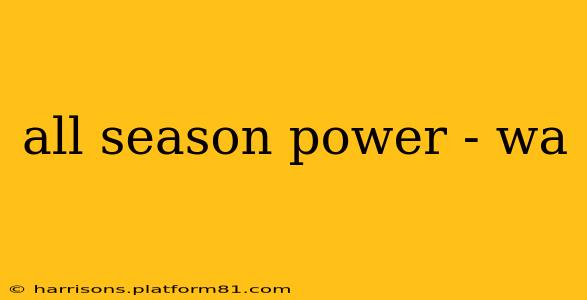Washington State boasts a diverse climate, experiencing everything from mild, rainy winters in the west to snowy, cold winters in the east. This variability significantly impacts energy consumption, making understanding and managing all-season power needs crucial for residents and businesses alike. This guide explores the unique energy challenges of WA and offers strategies for efficient and reliable power throughout the year.
What are the typical energy demands in Washington State throughout the year?
Washington's energy demands fluctuate considerably throughout the year. During the summer, increased use of air conditioning in hotter regions, coupled with higher demand for irrigation in agriculture, drives up energy consumption. Conversely, winter brings heightened demand for heating, especially in the eastern parts of the state, where temperatures plummet. The Pacific Northwest's reliance on hydroelectric power also means that water levels and rainfall directly impact energy availability. Low water levels during dry summers can constrain hydropower generation, potentially leading to higher electricity prices and increased reliance on alternative energy sources.
How does Washington's climate affect energy consumption?
Washington's varied climate significantly influences energy consumption patterns. The western region, with its moderate temperatures and abundant rainfall, generally experiences lower heating demands than the eastern part of the state. Eastern Washington's colder, drier climate necessitates greater energy use for heating homes and businesses during winter months. This geographical difference necessitates varied approaches to energy efficiency and management across the state. Coastal areas may require more energy for cooling and dehumidification during the summer, while inland areas grapple with extreme temperature fluctuations throughout the year, impacting energy needs across heating and cooling.
What are some energy-efficient practices for homes in WA?
Implementing energy-efficient practices is key to managing all-season power needs in Washington. For both summer and winter, proper insulation is crucial to minimize heat loss and gain. Consider upgrading to high-efficiency windows and doors to further improve energy performance. In summer, utilize ceiling fans and energy-efficient air conditioning units, and consider natural ventilation strategies. During winter, programmable thermostats allow for optimized heating schedules, reducing energy waste. Switching to LED lighting throughout the home can significantly reduce energy consumption year-round. Regular maintenance of heating and cooling systems is also essential to ensure optimal performance and efficiency.
What are the best energy sources for Washington State?
Washington boasts a diverse energy portfolio. Hydropower remains a dominant source, providing clean, renewable energy. However, its variability due to water availability necessitates diversification. Wind energy plays a significant role, particularly in eastern Washington's windy plains. Solar power is also growing in popularity, although its effectiveness is regionally dependent due to varying sunlight hours. Geothermal energy holds potential in specific regions with geothermal activity. The state is actively pursuing further development of renewable energy sources to create a more resilient and sustainable energy system for all seasons.
What government programs are available to help with energy costs in WA?
The Washington State government offers various programs designed to assist residents and businesses in managing energy costs. These programs often include rebates and incentives for energy-efficient upgrades, such as installing high-efficiency heating and cooling systems, solar panels, or improving insulation. Several utility companies also offer similar programs tailored to their service areas. It’s crucial to research and explore these options to access potential cost savings and reduce energy consumption. Furthermore, many programs focus on energy assistance for low-income households, ensuring access to affordable and reliable energy services.
How can I prepare my home for all seasons in Washington?
Preparing your home for all seasons involves proactive measures to minimize energy consumption and maximize comfort. This includes inspecting and maintaining your heating and cooling systems before the onset of each season. Ensure adequate insulation in your attic, walls, and floors to prevent heat loss during winter and heat gain during summer. Conduct regular maintenance of your windows and doors, sealing any air leaks to improve energy efficiency. Consider installing weather stripping around windows and doors, or upgrading to more energy-efficient alternatives. Regularly cleaning or replacing air filters ensures efficient operation of your heating and cooling systems.
This comprehensive guide provides a solid foundation for understanding and managing all-season power in Washington State. Remember to consult with local energy providers and government resources for specific programs and recommendations tailored to your region and energy needs. By combining proactive planning with energy-efficient practices, Washington residents can enjoy reliable and comfortable homes while minimizing their environmental impact.
